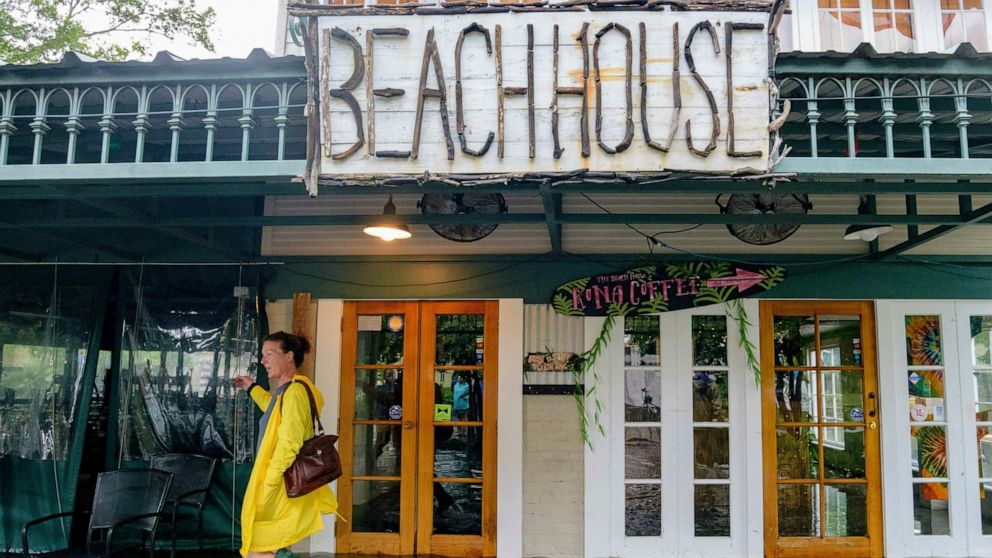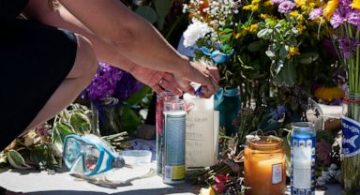
The Latest on Barry (all times local):
5:25 p.m.
New Orleans’ mayor is urging city residents not to let their guard down as Tropical Storm Barry weakens and moves farther inland.
Forecasters had worried that flooding rains from the storm would start hitting the city as early as Friday night. But Saturday was largely calm in New Orleans. There were intermittent bands of rain and gusty winds, but no flooding as of Saturday evening.
Still, city officials say a flash flood watch has been extended until Sunday at 7 p.m. Mayor LaToya Cantrell says New Orleans residents “are not out of the woods with this system.”
Barry has caused numerous problems along Louisiana’s coast — including overtopping of levees that protect communities in Plaquemines, St. Mary and Terrebonne parishes.
———
4:50 p.m.
Tropical Storm Barry’s winds have weakened and the Louisiana coast is no longer under a hurricane warning.
The National Hurricane Center said Saturday afternoon that the storm’s maximum sustained winds have fallen to 65 mph (105 kph). Officials expect Barry to weaken and become a tropical depression Sunday as it moves inland, meaning its winds would fall below 39 mph (63 kph).
Still, the center continues to warn of dangerous storm surge, heavy rains and strong winds.
The hurricane warning that had been in effect from Intracoastal City to Grand Isle has been downgraded to a tropical storm warning. Also, the Louisiana coast east of the mouth of the Mississippi River is no longer under a tropical storm warning.
The storm’s center was located about 20 miles (32 kilometers) west-southwest of Lafayette.
———
4 p.m.
Officials in a rural coastal parish in Louisiana have ordered an evacuation due to water overtopping a levee.
Terrebonne Parish President Gordon Dove ordered the evacuation of areas south of the Falgout (FAL’-goo) Canal.
It was unclear how many people would be affected. Evacuees with nowhere to go were directed to a shelter in Houma.
The Lower Dularge East Levee was overtopped as Hurricane Barry was moving ashore in south Louisiana. Barry was later downgraded to a tropical storm. The slow-moving system did not pose a threat to Mississippi River levees as once feared. But surge and heavy rains led to the overtopping of the levee in Terrebonne, and another levee in coastal Plaquemines Parish.
———
3:55 p.m.
Mississippi Gov. Phil Bryant says parts of the state can expect heavy rain from Tropical Storm Barry, including areas of the rural Delta that have been flooded for months.
As Barry moves northward through Louisiana, Bryant says its outer bands will affect Mississippi. At a Saturday news conference, Bryant noted that “there is a lot of water out there, and it is headed our way.”
The Mississippi Emergency Management Agency stationed search-and-rescue teams at the Camp Shelby military base near Hattiesburg and in southwestern Mississippi’s Pike County, near the Louisiana line. The Mississippi National Guard has 3,200 soldiers on standby.
More than 540,000 acres (291,000 hectares) in the Delta, north of Vicksburg, have been flooded since February. Bryant says rains from Barry could worsen that problem.
———
3:30 p.m.
Forecasters say the entire region affected by Tropical Storm Barry is still susceptible to extreme levels of rainfall.
Kevin Gilmore is a meteorologist with the National Weather Service in New Orleans.
Gilmore said Saturday that the overall rain forecast is for 2 to 4 inches (5 to 10 centimeters) in New Orleans and 6 to 10 inches (15 to 25 centimeters) in Baton Rouge.
But he says as much as 10 to 20 inches (25 to 50 centimeters) could still fall in the places where Barry’s rain bands set up — and that could be in either of those two cities.
He says it “really depends on where the bands set up.”
———
3 p.m.
Tropical Storm Barry’s outer bands dumped heavy rain on some areas of coastal Alabama, closing roads and snarling traffic.
John Kilcullen of the Mobile County Emergency Management Agency said Saturday some roads were closed in low-lying coastal areas.
He said motorists were urged to be cautious after the downpours – along with standing water – contributed to a number of accidents in the county. The National Weather Service on Saturday issued a flash flood warning for Alabama’s two coastal counties.
Kilcullen said the heavy rain is the primary concern from the storm.
Double red flags at the Alabama beaches in Baldwin County, Alabama warned tourists that waters were closed for swimming.
———
2:50 p.m.
Oil and gas operators have evacuated hundreds of platforms and rigs in the Gulf of Mexico to escape Tropical Storm Barry.
The U.S. Bureau of Safety and Environmental Enforcement says 283 (42 of 669 manned platforms (used for drilling and processing) have been evacuated.
Operators have also evacuated 10 of 21 stationary rigs (used just for drilling) and pulled six of 20 moveable rigs out of the storm’s path.
The bureau compiles the numbers from industry reports. The bureau estimates that nearly 70% of Gulf oil production and 56% of gas production were turned off Saturday.
———
2:15 p.m.
Authorities say Tropical Storm Barry is unlikely to push the Mississippi River over the levees that protect the city of New Orleans.
U.S. Army Corps of Engineers official Mark Wingate told reporters on a conference call Saturday that officials “see no concerns at all about (water) overtopping the Mississippi River levees.”
Wingate noted that the river is currently at 16.6 feet (5 meters) and is predicted to rise to about 17 feet (5.2 meters), down from the previously anticipated level of about 20 feet (6 meters).
Wingate also says all of the city’s canal locks are in good shape.
———
1:15 p.m.
Nearly all businesses in Morgan City were shuttered as coastal Louisiana braced for the arrival of Tropical Storm Barry.
One exception was Meche’s Donuts Shop, where owner Todd Hoffpauir did a brisk business Saturday despite the pounding winds and pulsating rain.
Hoffpauir said he didn’t plan to open at all. He arrived at his shop in the early morning to prepare dough for kolaches when police from the nearly department showed up to ask for coffee.
Hoffpauir said he didn’t expect to have any customers because the weather was so bad. Instead, his store was packed.
Over the next five hours, Hoffpauir made 23 pots of coffee and countless numbers of doughnuts.
He said: “I must have done a thousand dollars’ worth of business today.”
———
1:10 p.m.
Louisiana Gov. John Bel Edwards says none of the main levees on the Mississippi River in the state has failed or been breached so far because of Tropical Storm Barry.
But he warned at a news conference on Saturday that the storm is just beginning and the state faces significant threats in the days ahead.
Authorities have previously said water was flowing over the tops of a few levees in areas south of New Orleans. But those are not the main levees protecting the Mississippi River.
The storm threatening the Louisiana coast weakened from a hurricane to a tropical storm as it made landfall.
———
1 p.m.
Barry has made landfall in Louisiana and has weakened to a tropical storm.
The National Hurricane Center says the storm arrived on land Saturday afternoon.
The storm’s center was located about 5 miles (10 kilometers) northeast of Intracoastal City, and about 30 miles (50 kilometers) south-southwest of Lafayette, Louisiana.
Maximum sustained winds were clocked at 70 mph 115 (kph).
The center is warning of dangerous storm surge, heavy rains and strong winds.
National Hurricane Center director Ken Graham said that Barry had gathered “a big slough of moisture” and was expected to dump rain on the area throughout the weekend.
He describes Barry’s slow-moving trajectory as enabling it to gather immense amounts of water that it will eventually dump over saturated areas well inland, flooding rivers and creeks.
———
11:10 a.m.
The heaviest rains on land from lopsided Hurricane Barry have hit coastal Alabama and Mississippi the hardest.
Dauphin Island Mayor Jeff Collier said Saturday that parts of his barrier island in Alabama are flooded from both the driving rain early Saturday and surging water from the Gulf of Mexico.
Collier was driving around in a Humvee to survey the damage. He said the island still has power and wind damage was minimal.
The Category 1 hurricane was nearing shore some 200 miles (320 kilometers) from Dauphin Island, but Collier says the island often sees impacts from storms far away.
———
10:10 a.m.
The storm threatening the Louisiana coast has strengthened to a Category 1 hurricane.
The U.S. National Hurricane Center said in its 11 a.m. Saturday advisory that Barry had reached maximum sustained winds of 75 mph (120 kph), with higher gusts.
Hurricane-force winds were measured some 45 miles (75 km) to the east of the storm’s center, which was located 40 miles (65 kilometers) south of Lafayette, Louisiana. It was moving northwest at 6 mph (9 kph).
Weather forecasters said a hurricane warning is in effect for Intracoastal City to Grand Isle. Such a warning means that hurricane conditions are expected within the warning area.
———
9:55 a.m.
Authorities say water is flowing over the tops of a few levees in areas south of New Orleans as Tropical Storm Barry nears the coast.
Officials said Saturday morning the levees are in lower Plaquemines Parish and are not the main levees protecting the Mississippi River.
Plaquemines Parish emergency workers told news outlets they are getting crews to check the levees and make any repairs needed.
The levees are near Myrtle Grove and Pointe Celeste, and the water is threatening Highway 23, one of the main roads through the parish.
Louisiana Lt. Gov. Billy Nungesser told WVUE-TV anyone who remains south of Myrtle Grove should evacuate from the finger of low-lying, flood prone land that follows the Mississippi River to the Gulf of Mexico.
Much of Plaquemines Parish had been under an evacuation order since Thursday.
———
8:05 a.m.
National Hurricane Center director Ken Graham said Tropical Storm Barry is gathering “a big slough of moisture” just off the central Louisiana coast and is taking its time to come ashore Saturday morning, meaning “a lot of rain is on the way.”
Graham delivered a storm update using Facebook Live from the hurricane center, where he pointed to a computer screen showing a big swirling mess of airborne water. “That is just an amazing amount of moisture,” he said. “That is off the chart.”
He said the storm is moving so slowly that heavy rain will likely continue throughout the weekend across Louisiana. He said the highest tornado threat is on the east side of the storm, along the Mississippi coast, and Mobile Bay. And the Mississippi River isn’t the only waterway to worry about: He says other rivers and creeks will be overflowing across several states.
Graham reminded viewers that “83 percent of fatalities from these systems have been from inland rain. So let’s stay off the roads. Let’s prevent these preventable fatalities.”
———
7:30 a.m.
The Coast Guard says it is in the process of rescuing more than a dozen people stranded on a remote Louisiana island by flooding from Tropical Storm Barry.
Petty Officer Lexie Preston said some of the people were on rooftops Saturday on the Isle de Jean Charles, about 45 miles (72 kilometers) south of New Orleans.
Preston told The Associated Press the rescue is ongoing and four people and a cat have been taken from the island on a helicopter. She said a boat is also heading to the area to help get the rest of the people off the island.
Preston says she does not know the condition of the people rescued.
Terrebonne Parrish placed the island under a voluntary evacuation and the only two-lane road to it was cut off by floodwaters.
The island is the home of the Isle de Jean Charles Band of Biloxi-Chitimacha-Choctaw Tribe and is part of the southern Louisiana bayous threatened by rising sea levels.
———
7 a.m.
Tropical Storm Barry is strengthening as it approaches the Louisiana coast.
The U.S. National Hurricane Center said in its 8 a.m. Saturday advisory that the storm’s maximum sustained winds have increased 5 mph over the past several hours to 70 mph (115 kph), with higher gusts.
Barry is expected to reach hurricane strength by the time its center reaches the Louisiana coast, expected before noon local time. The storm is expected to weaken after it moves inland.
The storm is moving northwest at about 5 mph (7 kph), and a turn to the north is expected late Saturday or early Sunday.
Weather forecasters say Barry could dump between 10 and 20 inches of rain over south-central and southeast Louisiana and southwest Mississippi.
———
5:35 a.m.
The city closest to where Tropical Storm Barry is predicted to make landfall is already seeing power outages.
Some Louisiana parishes around Morgan City were reporting more than half their customers without electricity around daybreak Saturday.
A long day in Morgan City started with on and off rain. People were using cellphones to see in the dark and opening doors and windows to let the warm, sticky tropical air circulate.
Barry’s center is expected to slowly move onshore near Morgan City later Saturday.
East of Morgan City in New Orleans, only scattered showers and a light breeze stirred up the famous French Quarter. But forecasters warned that heavy rains and possible flooding were coming within hours.
In the New Orleans suburbs, the storm’s approach filled Lake Pontchartrain 3 feet (1 meter) above typical levels. Winds pushed water onto streets on the north side of the lake near Mandeville.
———
4:45 a.m.
Tropical Storm Barry cut short a predominantly black sorority’s convention, but meals left over from the conference will help feed tens of thousands of people in Louisiana.
Second Harvest Food Bank spokesman Jay Vise says a caterer had more than 17,000 uneaten meals after the storm caused Delta Sigma Theta Sorority to end its New Orleans convention a day early.
Vice says Second Harvest was able to get a truck and take the meals back to its headquarters Friday.
Vice told The Times-Picayune/The New Orleans Advocate the meals will be put in a freezer until the storm passes Monday, and then delivered throughout southern Louisiana.
———
4:10 a.m.
Nearly 50,000 people are without power as Tropical Storm Barry nears landfall on Louisiana’s south-central coast.
According to Entergy Louisiana’s outages map, more than 45,800 people had been affected by power outages as of 4:11 a.m. Saturday. Nearly a fourth of those outages were in coastal Terrebonne Parish. A number of other southern parishes were affected, including Jefferson Parish outside of New Orleans.
Those parishes were east of Morgan City, where Barry is expected to make landfall as a hurricane later Saturday morning. A 4 a.m. Saturday advisory from the U.S. National Hurricane Center said Barry was around 55 miles (90 kilometers) southwest of Morgan City.
The utility serving the area west of Morgan City, Cleco Power, indicated more than 3,000 people had been affected by power outages as of 4:15 a.m.
———
3:50 a.m.
Tropical Storm Barry continues to move toward the Louisiana coast as forecasters expect it to make landfall as a hurricane.
A 4 a.m. Saturday advisory from the U.S. National Hurricane Center said Barry was around 55 miles (90 kilometers) southwest of Morgan City, near where it’s expected to make landfall later Saturday morning. The agency said rain bands had begun to move onshore, with storm surge, heavy rains and wind expected across the north-central Gulf coast.
According to the advisory, the storm is expected to move northward through the Mississippi Valley through Sunday night, although steady weakening is expected as it moves inland from the south-central coast. The edges of the storm have already started lashing Louisiana with rain and left some coastal roads underwater.
The storm was 165 miles (260 kilometers) west of the mouth of the Mississippi River, with maximum sustained winds of 65 mph (105 kph) and higher gusts.
———
3:05 a.m.
A federal judge has issued a temporary restraining order barring Iberville Parish from deploying AquaDams that East Baton Rouge Parish says could increase flooding within its own borders.
Late Friday and hours before Tropical Storm Barry was expected to make landfall on the southern Louisiana coast, a judge ruled that the water-filled flood control barriers could cause substantial property damage and loss of life in the neighboring parish.
Iberville Parish President Mitch Ourso had planned to erect the AquaDams along Bayou Manchac, to prevent flooding in the Spanish Lake area. East Baton Rouge Parish Mayor-President Sharon Weston Broome told The Advocate she didn’t want to sue but had heard from worried constituents.
Ourso told WBRZ-TV he would abide by the ruling.
The judge set a hearing for Monday afternoon.
———
2:15 a.m.
More than 30,000 people have lost power in Louisiana as Tropical Storm Barry moves closer to landfall on the south-central coast.
According to Entergy Louisiana’s outages map, more than 29,000 customers had been affected by power outages as of 2:11 a.m., local time, Saturday. The biggest outages were in Jefferson, Lafourche, Assumption and Terrebone parishes, all located in southern Louisiana.
The parishes are east of Morgan City, where Barry is expected to make landfall as a hurricane later Saturday morning.
The utility serving the area around and west of Morgan City, Cleco Power, indicated more than 3,000 people had been affected by power outages as of 2:10 a.m.
The outages coincided with National Weather Service-issued tornado warnings for three parishes bordering Jefferson Parish to the west, near New Orleans. The warnings expired at 2:15 after the storm moved out of the area.
———
2 a.m.
The National Weather Service has again extended tornado warnings in the New Orleans area as Tropical Storm Barry moves toward the southern Louisiana coast.
The latest bulletin Saturday morning moved the tornado warnings north, from northwestern Plaquemines Parish and southwestern St. Bernard Parish to northwestern St. Bernard Parish and central Orleans Parish.
The agency said a “severe thunderstorm capable of producing a tornado” was located east of Chalmette, moving north at 50 mph (80 kph). The updated bulletin said the storm would near New Orleans around 2:15 a.m. local time.
Residents were advised to take cover immediately. The agency said pea-sized hail could accompany the winds.
Barry is expected to make landfall near Morgan City later Saturday morning.
———
1:40 a.m.
As Tropical Storm Barry inches toward the southern Louisiana coast, a severe thunderstorm capable of producing tornadoes is moving toward New Orleans.
The National Weather Service issued a bulletin extending tornado warnings for St. Bernard Parish and Plaquemines Parish early Saturday.
The original bulletin said a severe thunderstorm capable of producing a tornado was located over Port Sulphur in Plaquemines Parish, moving north at 50 mph. An update 15 minutes later said the thunderstorm would near New Orleans near 2 a.m. local time.
Residents were advised to take cover immediately. The agency said pea-sized hail could accompany the winds.
Barry is expected to make landfall near Morgan City later Saturday morning.
———
1:25 a.m.
The National Weather Service has issued tornado warnings for parishes in the New Orleans area as Tropical Storm Barry approaches the southern Louisiana coast.
The agency issued tornado warnings for southwestern St. Bernard Parish and northwestern Plaquemines Parish early Saturday. A bulletin said a severe thunderstorm capable of producing a tornado was located over Port Sulphur in Plaquemines Parish, moving north at 50 mph. The bulletin said winds could be accompanied by pea-sized hail.
Residents were advised to take cover immediately. The advisory was in effect until 1:30 a.m., local time.
Barry is expected to make landfall later Saturday morning near Morgan City.
———
1:10 a.m.
Tropical Storm Barry continued to inch toward the Louisiana coast as forecasters expect it to make landfall as a hurricane.
An early Saturday advisory from the U.S. National Hurricane Center said Barry was around 70 miles (115 kilometers) south of Morgan City, near where it’s expected to make landfall later Saturday morning.
According to the advisory, the storm is expected to move northward through the Mississippi Valley through Sunday night, although steady weakening is expected as it moves inland from the south-central coast. The edges of the storm have already started lashing Louisiana with rain and left some coastal roads underwater.
The storm is currently 125 miles (200 kilometers) west of the mouth of the Mississippi River, with maximum sustained winds of 65 mph (105 kph) and higher gusts.
———
11:35 p.m.
People have boarded up buildings and braced for a strengthening Tropical Storm Barry that threatened millions as it churned a path ashore.
The storm is testing efforts to guard against flooding since Hurricane Katrina devastated New Orleans 14 years ago.
Officials predicted Barry would make landfall Saturday morning near Morgan City as the first hurricane of the season.
The edges of the storm have already started lashing Louisiana with rain and left some coastal roads underwater.
But late Friday night, residents received good news from forecasters. Experts predict the Mississippi River will crest in New Orleans at about 17.1 feet (5.2 meters), not 19 feet (5.8 meters) as had been earlier predicted.
The levees protecting the city range from about 20 to 25 feet (6 to 7.5 meters) in height.
————
For the latest on Tropical Storm Barry, visit https://apnews.com/Hurricanes .





